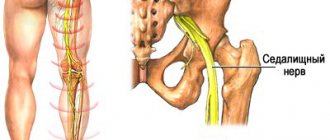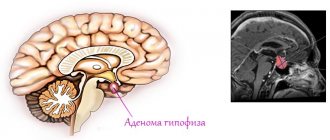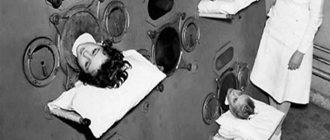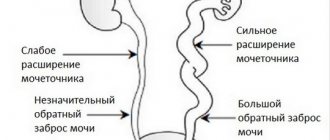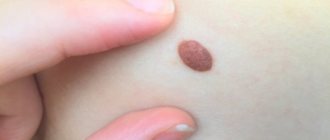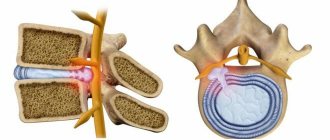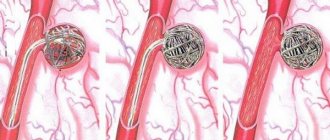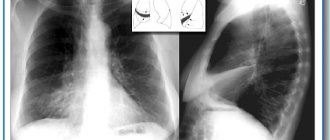Symptoms of inflammation of the optic nerve
Damage to the optic nerve is a pathology characterized by inflammation of the nerve sheaths or fibers. Its symptoms may be: pain when moving the eyeballs, blurred vision, changes in color perception, photopsia, the eye may swell. Patients may complain of a decrease in the peripheral field of vision, vomiting, nausea, darkening of the eyes, and fever. Each form of optic nerve damage has its own symptoms.
Intrabulbar neuritis develops suddenly and acutely, and the nerve is completely or partially affected. Total inflammation greatly impairs vision, sometimes causing blindness. A characteristic sign of the disease is the formation of scotomas. A person's adaptation to darkness and color perception are impaired. After a month, the symptoms may subside, and in severe cases, blindness and atrophy of nerve fibers develop.
The most important clinical sign of intracranial retrobulbar inflammation is considered to be low vision. Symptoms include decreased vision and pain in the eye socket. The transversal form of retrobulbar neuritis is severe. In many cases the person goes blind. During the first three weeks of the disease, changes in the fundus of the eye are not observed, but they manifest themselves later.
Symptoms may vary depending on the reasons that caused the nerve inflammation:
- If the disease is caused by rhinitis, the patient complains of deterioration in visual acuity, poor perception of bright colors, and changes in the size of the blind spot.
- With syphilis, minor defects in the form of redness of the disc are observed. In severe forms of the disease, acuity and peripheral vision deteriorate.
- Neuritis caused by tuberculosis is characterized by the development of a tumor-like formation that completely covers the optic nerve head. Sometimes it goes to the retina.
- Damage to the optic nerve in typhus is considered dangerous. If the disease is advanced, then after a few weeks nervous atrophy occurs.
- With malaria, one optic nerve is affected and swelling develops.
Classification of optic neurites
The first signs may appear unexpectedly and abruptly. Usually the process begins with a decrease in visual acuity or pain in the orbital area. Depending on which part of the visual pathway is affected, retrobulbar and intrabulbar neuritis are distinguished.
Kinds:
- intrabulbar (true) neuritis, when the inflammatory process affects the optic nerve and optic disc inside the orbit;
- retrobulbar neuritis, when inflammation is concentrated behind the eyeball and affects the axial bundle of nerve fibers.
Causes
One of the factors that can provoke diseases of the optic nerve is multiple sclerosis. This affects the myelin covering the nerve cells of the spinal cord and brain. Damage to the brain's immune system develops. People with brain disorders are at risk. Damage to the optic nerve is caused by autoimmune diseases such as sarcoidosis and lupus erythematosus.
Neuromyelitis optica leads to the development of neuritis. This occurs because the disease is accompanied by inflammation of the spinal cord and optic nerve, but no damage to brain cells. The appearance of neuritis is also provoked by other factors:
- The presence of cranial arteritis, characterized by inflammation of the intracranial arteries. Disturbances occur in the blood circulation, blocking the supply of the required amount of oxygen to the cells of the brain and eyes. Such phenomena provoke a stroke and loss of vision in the future.
- Viral, infectious, bacterial diseases, measles, syphilis, cat scratch disease, herpes, rubella, Lyme disease, neuroretinitis lead to inflammation of the nerve, the development of chronic or purulent conjunctivitis.
- Long-term use of certain medications that can provoke the development of nerve inflammation (Ethambuton, prescribed for the treatment of tuberculosis).
- Radiation therapy. Prescribed for certain diseases that are severe.
- Various mechanical effects - severe intoxication of the body, tumors, insufficient supply of nutrients to the cornea and retina.
Gymnastics
gymnastics for the eyes
Eye exercises are also useful in case of development of neuritis. Therefore, by regularly doing such gymnastics, you improve the functions of your visual organs. To perform the exercise, you need to close your eyes, then open/close them in turn (10 times). Close your eyes again, then, without opening them, move them first to the right side, then to the left. The same number of times as in the previous exercise. To treat episcleritis of the eye, medications or UHF therapy may be prescribed.
Diagnostic methods
Methods for detecting inflammation of the optic nerve are based on clinical manifestations, since in most cases the pathology is not detected during examination of the fundus. To exclude the presence of multiple sclerosis, a study of cerebrospinal fluid and MRI (magnetic resonance imaging) is performed. With the help of timely diagnosis, you can prevent and cure this disease, otherwise blindness and nerve atrophy will develop.
Fluorescein angiography of the fundus
This diagnostic method refers to objective methods of examination by contrasting the vessels inside the eye with fluorescein, which is administered intravenously. In pathological conditions, the eye barriers, which work normally, are destroyed, and the bottom of the eye takes on a form that is characteristic of a particular process. Interpretation of fluorescein angiograms is based on a comparison of the characteristics of the passage of fluorescein through the wall of the retina and choroidal vessels with the clinical picture of the disease. The price of the study is 2500-3000 rubles.
Articles on the topic
- Eye stroke - first manifestations and types of pathology, drug therapy and preventive measures
- Intracranial hypertension: signs and treatment
- Tablets for osteochondrosis: types and uses
Electrophysiological study
This diagnostic procedure is a series of highly informative techniques for studying the functions of the retina, optic nerve, and areas of the cerebral cortex. Electrophysiological examination of the eye is based on recording its reaction to specific stimuli. The ophthalmologist and the doctor who conducts the examination work closely with each other to set the right task and decide on the diagnostic method. This study is considered the most informative and effective. The cost of diagnostics is 2500-4000 rubles.
Prevention
Preventive measures are needed in order to exclude the possible occurrence of the disease. Let's look at the most basic recommendations:
- avoid head injuries;
- adhere to a healthy lifestyle, and avoid drinking alcohol in any doses;
- take vitamins to strengthen the immune system;
- be sure to follow basic hygiene rules;
- avoid infectious diseases;
- See a doctor periodically.
Symptoms of dirofilariasis in humans are itching, burning and headache.
With timely detection and proper treatment, the prognosis is favorable. Recovery of the body occurs 2-3 months after therapy. 75% of women and 34% of men develop multiple sclerosis after suffering from pathology.
Prevention of optic neuritis is, first of all, timely treatment of general diseases of the body that can cause it. Therefore, you should follow these tips:
- Do not delay treatment of diseases that are within the competence of the ENT specialist.
- If nervous disorders appear, consult a neurologist.
- If you notice symptoms of eye diseases, visit an ophthalmologist.
- Avoid eye injuries.
Proper nutrition and giving up bad habits will help reduce the risk of developing the disease. Take care of your eyesight and visit your ophthalmologist periodically, even if you have no complaints.
To prevent optic nerve atrophy, you need to start treating ophthalmological diseases in a timely manner. At the first signs of a decrease in visual acuity, you must immediately make an appointment with an ophthalmologist. When atrophy begins, not a minute can be lost. If at the initial stage it is still possible to preserve most of the visual functions, then as a result of further atrophic changes the person may become disabled.
Treatment
If inflammation is suspected, the patient requires urgent hospitalization. While the cause of the disease remains unknown, therapy is carried out to suppress the infectious lesion and reduce the intensity of the inflammatory process. Tablets are prescribed for desensitization, dehydration, improving metabolic processes in nerve fibers and tissues, and increasing the body's immune forces. Medical staff prescribe a course of antibiotics or sulfonamide solutions intramuscularly for up to seven days.
Treatment of neuritis involves the use of corticosteroids simultaneously with Prednisolone. Diacarb is taken orally, which reduces the severity of edema. At the same time, Panangin is prescribed to reduce symptoms, Trental or Nicotinic acid is prescribed to improve blood supply. Piracetam, a complex of B vitamins, is taken internally, and Actovegin injections are prescribed. Dibazol is prescribed for several months.
When the cause of the development of the pathology is clarified, therapy is carried out aimed at its eradication (the use of antiviral drugs, anti-tuberculosis drugs, etc.), further rehabilitation, and prevention with the use of tablets and ointments. If bilateral toxic retrobulbar neuritis is diagnosed, occurring in response to administration of methyl alcohol, similar treatment without antibacterial medications is prescribed.
Where to treat eye disease
When choosing a clinic for the treatment of vision pathologies, pay attention to the medical institution’s ability to provide complete and timely diagnosis, effective and modern methods of therapy, and their cost. Consider the level of equipment of the hospital and the professionalism of the specialists. The experience of doctors helps to achieve better results in the treatment of eye diseases. Below you will find a list of clinics in Moscow and St. Petersburg where you can go if you have inflammation of the optic nerve:
- Clinic "Echinacea", Moscow, st. Skladochnaya, 6, building 7. Treatment of neuritis here is carried out in four directions: examination, elimination of the factor that caused harm, stopping the destruction of the nerve, blocking the activity of infection, stimulating regeneration.
- Moscow Eye Clinic, Moscow, Semenovsky Lane, 11. This is a high-level ophthalmological center that provides treatment, prevention, and diagnosis of eye diseases. The clinic employs leading ophthalmologists who have extensive practical experience and scientific achievements. The medical institution is equipped with innovative world-class operating and diagnostic equipment, which allows complex operations and diagnostics to be carried out.
- Center for Eye Surgery, Moscow, Smolensky Boulevard, 2. The staff of this institution consists of international-level specialists. The latest technologies have been introduced into practice. The participation of specialists in pathology conferences and the study of new ophthalmic trends helps ensure the safety and quality of services.
- Ophthalmological center ARTOX, Moscow, st. Gilyarovsky, 39. This medical institution combines the main methods of traditional ophthalmology and modern technologies.
- Clinic "Medinef", St. Petersburg, st. Botkinskaya, 15, bldg. 1. A multidisciplinary, highly professional medical institution that has a unique method of preventing and predicting the early stages of diseases. The clinic cooperates with many medical institutes, leading treatment and preventive institutions in Russia.
- Ophthalmological clinic "Excimer", St. Petersburg, Apraskin lane, 6. This medical institution has been operating for 17 years. Offers a full range of high-tech services for children and adults. The clinic has modern diagnostic equipment, unique microsurgical systems, and uses advanced technologies and techniques for solving various eye problems. It employs highly qualified ophthalmologists of various specializations.
- Medical, St. Petersburg, Bolshevikov Ave., 25/1. The activities of this institution are based on organizing the work of a wide range of specialists who are proficient in modern instrumental and clinical research methods.
Video
If vision diseases are not treated promptly, serious complications can develop. Neuritis has several forms, which are divided according to ophthalmoscopic and etiological classifications. The first is based on data obtained by examining the fundus, and the second is based on the reason that caused the dysfunction of the optic nerve. The following types of neuritis are distinguished: retrobulbar form, neuroretinitis, papillitis. Each of these inflammations has symptoms and treatment, which you will learn about in the YouTube video below.
Found an error in the text? Select it, press Ctrl + Enter and we will fix everything!


